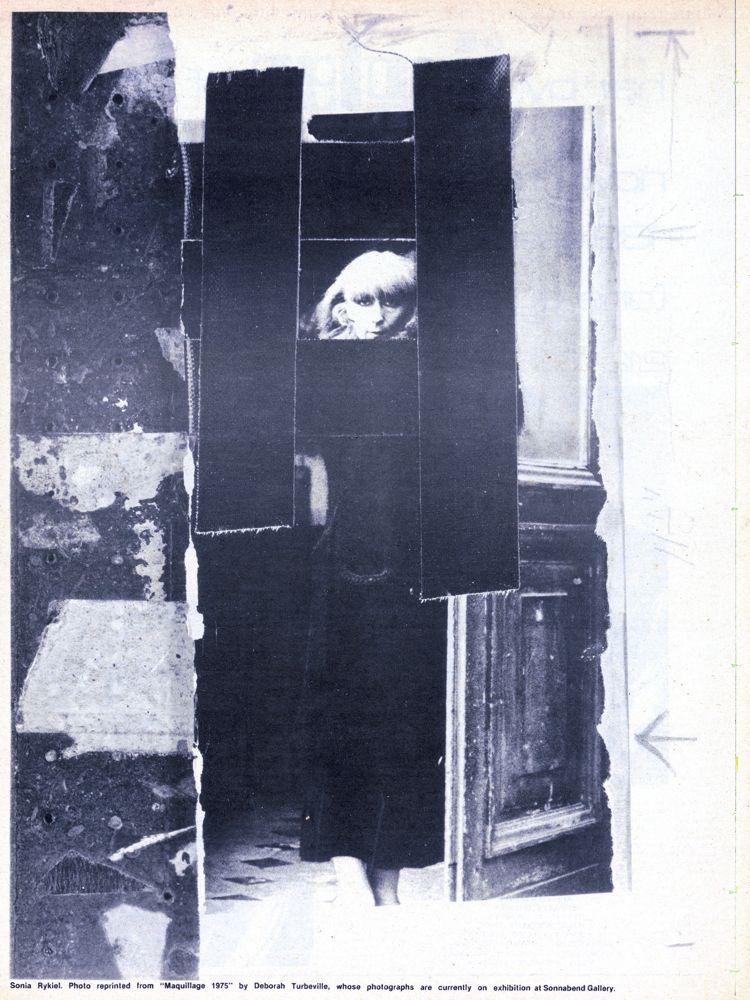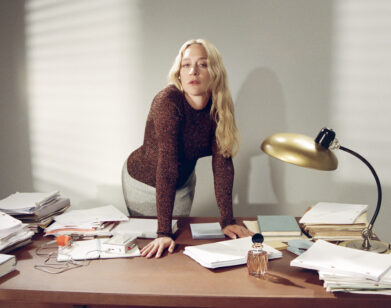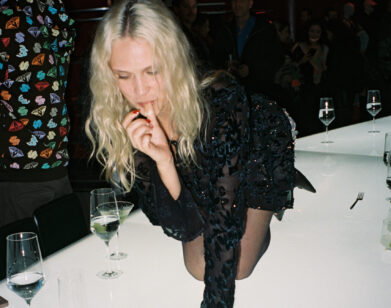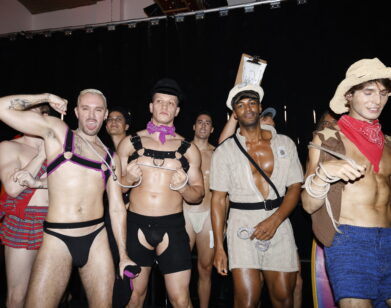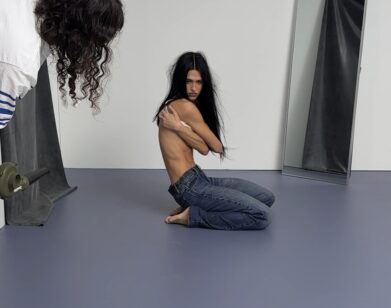New Again: Sonia Rykiel
If Sonia Rykiel doesn’t feel entirely “new again,” it’s only because she’s been at the forefront of what is new and imaginative since the start of her career in the ’60s. When we interviewed Sonia in her Paris studio for the May 1977 issue of Interview, her thoughts on androgyny, femininity, and the stylish woman’s uniform depicted a woman far ahead of her time. She designed the type of Parisian chic that she wore and that she loved and was hailed for it. Dubbed “the queen of knits” early in her career, Rykiel never stopped churning out collections with pockets and a disdain for bras that espoused a daring boyish comfort, and all the natural sexiness that accompanies it.
Gerlado de Conceicao was named creative director of the brand two years ago. Since then, Rykiel herself has taken a decidedly more passive role on the corporate side of things, but her influence on the brand’s creativity is still palpable. With her Fall/Winter 2014 show quickly approaching at Paris Fashion Week (it’s slated for this Friday), Sonia’s on our minds again, and for good reason; the fashion philosophy that she recounted to Maxime de la Falaise in 1977 jarringly rings just as true today as it sounded forward thinking almost 40 years ago. —Kenzi Abou-Sabe
Sonia Rykiel
By Maxime de la Falaise
Sonia Rykiel is one of a very few designers who play Pygmalion to multiple Galateas. In her case Aphrodite has worked overtime, for Sonia’s typical customer seems always on the move, striding boyishly along with hands thrust into pockets that are often just slits allowing for certain auto-erotic pleasures; scarves and tunic tails flutter in her wake. She can be, too, the sensuously self-absorbed woman, curious and intense, layered in subtle shades of knitted jersey, the body closely protected and embraced. Sonia only designs for herself, for her own compulsive needs that she projects into a radical uniform for a rich and elite clientele.
She is sitting in a storeroom above her shop in Paris. It is small, and the only light comes from long, low windows that run the width of the room. The light is poor as it is raining outside but Sonia seems not to notice as she concentrates on her sketches, working at a narrow table at right-angles to the window.
In this grey light, with her black sweater and pale skin she would be almost invisible were it not for an explosion of rose-gold hair that glows and crinkles and seems to send out light like a paper lantern. She is peering at some ink sketches through bangs that cover half her eyes, pointing to the additions she has made with colored pens: here a neckline in scarlet, there a mock waist-line cinched in by color, a green cuff, a blue stripe.
SONIA RYKIEL: All the same, there’s a limit to how much you can eliminate in a sketch and what you can do with one line. It’s very beautiful but what I love are the bits of color just dropped in like that!
Sonia has been making a TV special about her clothes, the camera often on her hands as she sketches: she dashes off a few lines to show what she means, starting with a narrow rectangle which quickly grows arms and becomes a sweater, an elongated skirt follows and the wrapped head gets added last—a cherry on the cake.
RYKIEL: There, I do the lines like this and like that, as I draw very badly it makes me rather nervous to be watched, but as they were filming the whole thing, I thought that for once I better make an effort, so I took these colors and just dropped them in like this!
MAXIME DE LA FALAISE: Perhaps they’ll suggest ideas for your next collection.
RYKIEL: Of course! Usually I don’t bother to draw with color but this effect is quite beautiful! This film will be translated into 27 languages and distributed everywhere!
DE LA FALAISE: Do you sell to all these countries?
RYKIEL: I don’t want to sell so much in quantity as to do it well with few but strong positions: the way I feel about life. Everything I do is really an expression of myself, through colors and shapes and, at the same time, I try to explain what I feel not only as a creator but also as a woman. I cannot separate one from the other. For instance, I’m not at all interested in doing clothes for movies or stage, in stage dressing or costuming. Nor can I design lingerie, for I never wear any! At one time I used to wear a lot of lingerie but now I’m in a mood of total nudity! I’m in a period when I’m trying to curl up and in lingerie, I feel that one spreads out! It’s just a phase in my life, it doesn’t mean that in three months or six or a year I won’t design lingerie! With the exception of lingerie and theater I’m interested in everything to do with clothes and perfumes: everything which is an extension of woman.
DE LA FALAISE: In anything that is feminine? What do you feel about women?
RYKIEL: I hate the word feminine! I mean, there is a woman and a man and when I say “woman” it suggests all that is radiant, tender, fascinating, gentle, demoniac, exaggerated! Feminine makes me think of somebody who is spindly and over-sweet: I don’t like that! The natures of men and women are very mixed and for me the most fascinating type of woman is the one who is a little masculine, has a little of the man in her, and the sort of man who is fabulous is the one who is a little woman too. It’s impossible not to mix them! A man is attractive when he is slightly disturbing like a woman; a woman when she’s a little disturbing like a man. She is superb when she has all the moving, endearing, mysterious woman’s nature and a boyish side too. But when one says that a woman is very feminine one has said all, there’s nothing to add! One stops dead there!
DE LA FALAISE: There is a very Scott Fitzgerald feeling about your clothes.
RYKIEL: Yes and look at Zelda! How masculine she was! She was a man and a woman! There I agree with you, the woman who walks, talks, moves, always ready for…
DE LA FALAISE: I’m beginning to see a woman dressed by you as wearing a monocle, being painted by Romaine Brooke, frequenting opium parties.
RYKIEL: I think that the boy-woman is a very strong image and a lot of fascinating women are like that: Gala [Dalí].
DE LA FALAISE: [Marlene] Dietrich?
RYKIEL: It’s the ambiguity which is disturbing and attractive. Your body can be very female, which is something you can do nothing about, but then you can have the soul, the mind and the spirit of both male and female. The women friends I am closest to somehow have this masculine side to them, they shove their hands in their pockets when they walk: I love that side.
DE LA FALAISE: And what sort of men do you like?
RYKIEL: The funny thing is that, physically at least, I like very manly men, rugged, even fat! Somehow I need that protective side in men. But the essence of seduction for me in a man, although it stems from his rough, almost rough-neck looks, still contains something of the woman: he must be seductive and intelligent.
DE LA FALAISE: How do you dress your men?
RYKIEL: In heavy sweaters and corduroy pants, in country clothes and above all in masses of scarves!
DE LA FALAISE: You adore scarves, don’t you?
RYKIEL: Yes, a scarf has to be the most beautiful thing ever invented to wear! It’s a winding, a continuity, an infinity! I love things that are endless, I hate them to stop. It’s like order and disorder: I rather love disorder and things that move, it’s a state where one gets more things done!
DE LA FALAISE: I love the way scarves look in sketches, always flying out behind!
RYKIEL: That’s exactly why I attached the scarves to the sweaters and dresses in a recent collection, it’s because a scarf is something you fling behind you! I love flinging everything I buy behind me onto the back-seat of the car: it’s always full of packages when I travel, when I leap in my car!
DE LA FALAISE: A real attic car.
RYKIEL: Yes, my attic-car, my trip-car! I love to leave, to be ready-for, to be on the run! That’s my boyish side, it’s the pant’s me! Pants which allow for the attitudes, gestures and movements of a man but that are still female in taste and free enough so that I can slip my hands inside!
DE LA FALAISE: How do you mean that?
RYKIEL: If you notice I always have a lot of vents and slits in the clothes I design, even inside the pockets so that I can slip my hands inside my clothes and touch my skin. I want to be able to feel my body naked inside my clothes.
DE LA FALAISE: What do you feel about the way women dress?
RYKIEL: Men and women are so alike that a woman must make an intellectual effort to differentiate herself. As soon as one understands who one is, one can disguise oneself any way one wants. As soon as one has found one’s look, one’s shape, one does not need to alter it too much, in fact I would say that one should not change it. One can have many versions of one’s personal statement but it’s mostly the mixtures of colors that should change and the way one layers the different basic elements. I don’t like women who are multiform, who wear many different shapes. Women who retain a unique shape are usually unique people.
DE LA FALAISE: I find it rather irritating to see women who only wear the clothes of one “from soup to nuts“!
RYKIEL: Some women who are intelligent, even intellectual, still do not know how to dress. Then it’s much better to choose something precise, a certain designer and stick to it. But women who can manage independently can dress quite uniquely out of the elements offered by designers. A very young girl, myself, and my 70-year-old mother all look quite different wearing some of the same clothes from my shop. The whole secret is to know how to do it and some people never will, just like some can’t make light pastry: they are lacking in some sort of grace. My clothes are put together out of different basic elements so that a woman can express the way she wants to look, transform, metamorphosize herself not as the woman I decided but as she herself wants to be.
DE LA FALAISE: And yet your clothes are judged to be a sort of uniform.
RYKIEL: We can both start with the same thing, as though we were cutting out paper dolls. With one shape we can each make a hundred that are completely different. For me a uniform is like that, it is more in the mind than a reality. I think that there are so many women who understand nothing about clothes and they should try and understand themselves before they start putting on disguises: they should stand in front of the mirror for a day, two days or three, and find out what they have which is beautiful, interesting: what they should show: hair, neck, arms, or hands. If women have pretty legs they should show them right up to the thighs. I would if I had pretty legs. They must realize themselves and then find their unique shape, their own uniform. I also think that clothes should be a shelter like a house or a rug. I think that there is that element of protection and a uniform can be just that. When one doesn’t feel well, one often feels like putting on an old sweater, or robe. One wants to feel sheltered by something that one has made one’s own, which represents one’s universe. I am very attached to this idea of the moments when one wants to be ‘homed’, in one’s right place somewhere and that’s what I expect of a uniform.
Sonia herself looks protected by her uniform as she sits gazing at me intensely ready to go on talking for hours although she has a plane to catch.
Downstairs a very old lady is helping her granddaughter choose a dress. She is pleased with it and pays in cash out of a large black bag: it represents a safe choice in her eyes, warm and simple. For her granddaughter it is dangerously seductive. Long live the uniform and vive la difference!
THIS ARTICLE INTIALLY APPEARED IN THE MAY 1977 ISSUE OF INTERVIEW.
New Again runs every Wednesday. For more, click here.

